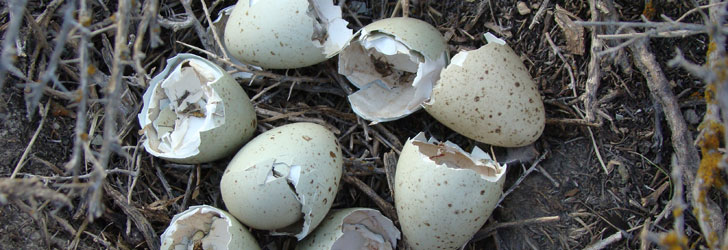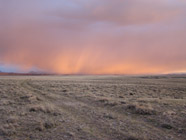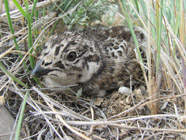

Dr. Jeffrey L Beck
Dept of Ecosystem Science and Management
Agriculture Building 2004
Department #3354
1000 E. University Ave
Laramie, WY 82071
Phone: (307) 766-6683
Fax: (307) 766-6403
Email: jlbeck@uwyo.edu



Dr. Jeff Beck
Postdoctoral Research Associate: Kurt Smith
MS Student: Jason LeVan
In spring 2011, we initiated a cooperative study near Jeffrey City, Wyoming with the Wyoming Game and Fish Department, the Lander Field Office of the USDI Bureau of Land Management, and local livestock producers in Fremont and Natrona Counties to better understand how greater sage-grouse (Centrocercus urophasianus) respond to vegetation treatments in Wyoming big sagebrush (Artemisia tridentata wyomingensis). Wyoming big sagebrush is the most widely distributed subspecies of big sagebrush and provides important habitat to sagebrush occurring wildlife. Sagebrush has long been treated through chemical application, mechanical treatments, and prescribed burning to increase herbaceous forage species released from competition with sagebrush overstory. However, it is not clear whether these same techniques improve habitat conditions for wildlife species that depend on sagebrush such as sage-grouse, particularly because Wyoming big sagebrush experiences slow regeneration (25–100+ years to return to pre-treatment conditions) following treatments and herbaceous cover and production typically return to pre-treatment conditions within 1-to-5 years post-treatment.
We designed our study to evaluate whether sagebrush treatments elicit a positive, negative, or neutral response in rates of nesting success, brood survival, and adult female survival for sage-grouse. We selected these rates because they largely influence growth of sage-grouse populations. We are also evaluating other responses to sagebrush treatments: 1) nutritional quality of treated Wyoming big sagebrush, 2) dietary resources (forbs and insects) used by chick sage-grouse, and 3) habitat selection patterns of grouse exposed to treatments. In addition, we established 6 grazing exclosures in each of our 4 treated study areas to investigate the effect of restricted and unrestricted cattle and wild horse grazing on post-treatment response in cover and production of herbaceous plants and sagebrush. Each exclosure includes treated and untreated sagebrush, compared to treated and untreated sagebrush outside exclosures.
Our study, designed as a Before-After Control-Impact study, uses annual data collected from approximately 100 radio-marked female sage-grouse that use 6 study areas. There are 2 study areas each that were mowed (to 10 inches), aerially applied with tebuthiuron, or serve as untreated controls. These 6 study areas range from 4,201–15,073 acres within a larger ~736,000 acre study area. We identified these study areas as important to nesting and brood-rearing sage-grouse during the pre-treatment phase of our study (2011–2013). We implemented on-the-ground mowing (1,208 total acres) and tebuthiuron (1,500 total acres) treatments in winter and spring 2014 in accordance with guidelines of the Wyoming Game and Fish Department Protocols for Treating Sagebrush to be Consistent with Wyoming Executive Order 2011-5; Greater Sage-grouse Core Area Protection (7/8/2011; WGFD 2011). During the third phase of our study we will evaluate post-treatment response of female sage-grouse for 5–10 years (2014–2023). Specifically, our study seeks to address the following questions:
Preliminary analyses evaluated the influence of habitat treatment practices on sage-grouse at the population level and then explored potential mechanisms that may explain how populations are influenced by treatments (Smith 2016). Major findings suggest that 1) within Core Areas in sage-grouse Management Zone II, prescribed burning and mechanical treatment were negatively and chemical treatments positively associated with sage-grouse population change for up to 11 years post treatment, 2) mowing and tebuthiuron treatments may slightly increase crude protein concentrations directly after treatments without immediate changes in plant secondary metabolites of sagebrush leaves, and 3) treated big sagebrush habitats contained forb and insect abundances that did not differ from untreated habitats and were used equal to or less than untreated habitats by brood-rearing females over the short-term following treatments. Identifying fine scale demographic responses and use of treated habitats in our ongoing study will aid in determining the efficacy of treatments in Wyoming big sagebrush intended to enhance habitat for sage-grouse as well as other species of wildlife associated with the sagebrush biome.
The following articles using data collected from this study have been published in peer-refereed outlets:
Dinkins, J.B., K.T. Smith, J.L. Beck, C.P. Kirol, A.C. Pratt, and M.R. Conover. 2016. Microhabitat conditions in Wyoming’s sage-grouse Core Areas: Effects on nest selection and success. PloS ONE 11(3): E0150798.
Pratt, A.C., K.T. Smith, and J.L. Beck. 2017. Environmental cues used by greater sage- grouse to initiate altitudinal migration. The Auk: Ornithological Advances 134:In press.
Smith, K.T., J.L. Beck, and A.C. Pratt. 2016. Does Wyoming’s Core Area policy protect winter habitats for greater sage-grouse? Environmental Management 58:585-596.
LITERATURE CITED
Smith, K.T. 2016. Identifying habitat quality and population response of greater sage-grouse to treated Wyoming big sagebrush habitats. PhD dissertation, University of Wyoming, Laramie.
Wyoming Game and Fish Department. 2011. Wyoming Game and Fish Department protocols for treating sagebrush to benefit sage-grouse.
Dr. Jeffrey L Beck
Dept of Ecosystem Science and Management
Agriculture Building 2004
Department #3354
1000 E. University Ave
Laramie, WY 82071
Phone: (307) 766-6683
Fax: (307) 766-6403
Email: jlbeck@uwyo.edu